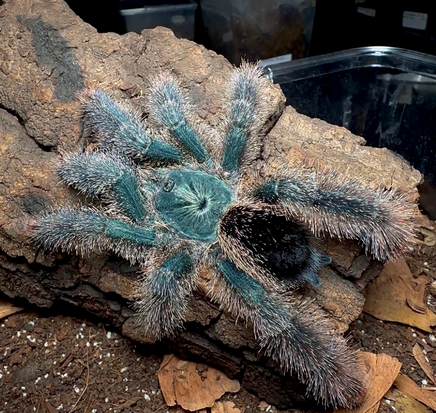
Avicularia metallica
White Hair Pinktoe / Metallic Pinktoe
This is your laid-back, tree-dwelling beauty. Silky smooth appearance with subtle metallic tones and those signature white feet. One of the more recognizable Avics, and for good reason—gentle behavior and reliable appetite. A classic arboreal for collectors or anyone new to the hobby.
Care Details:
-
Temperature: 75–85°F (24–29°C). They’ll eat, grow, and molt faster with warmth.
-
Humidity: 75–80%. Keep it lightly moist. I don’t use water dishes, but if you do, no harm. Avoid soaking wet or dusty dry substrate.
-
Housing (Arboreal):
-
Babies: Small vial—5" tall x 2" wide, ventilated.
-
Juveniles (2"+): 7–8" tall enclosure with anchor points.
-
Adults: 12–16" tall, vertical space with good cross ventilation.
-
🆓 Free vial available for slings—must request it at checkout or it won’t be included.
-
Diet:
I feed mine crickets, Dubia, red runners, lobster roaches, and hissers. For babies, use baby crickets or roaches.
Too big? Crush the head and drop it in—they’ll figure it out.
Pinky mice or lizards are okay occasionally, but don’t overdo it. High calcium = possible digestive issues.
In-Depth Facts:
-
Latin name: Avicularia metallica
-
Common names: Metallic Pinktoe, White Hair Pinktoe
-
Locale: Venezuela and surrounding tropical regions in northern South America
-
Category: Arboreal; light to moderate webbing; tube webs up high
-
Size: Females reach around 5 inches, males a bit smaller
-
Urticating hairs: Yes—very reluctant to use, usually flees or stays calm
-
Growth rate: Moderate
-
Life span: Females live 10–12 years, males 2–3
-
Recommended levels: Everyone—especially beginner keepers and Avic lovers
Stay Connected:
⚠️ Safety Disclaimer:
Experiencing a tarantula bite is an extremely rare occurrence, and it's important to note that there have been no recorded fatalities due to a tarantula bite. The venom potency varies across species, with Old World tarantulas generally having stronger venom than their New World counterparts. Within the Old World category, the Poecilotheria genus is known for having particularly potent venom.
It's crucial to approach tarantulas with respect and understanding. If you happen to get bitten—which is unlikely—the key is to stay calm. In most cases, the discomfort is superficial and subsides within a few minutes to a few hours. However, bites from species with more potent venom may result in symptoms lasting up to a week. Remember, larger tarantulas tend to have more venom than smaller ones.
Please be aware that I cannot assume responsibility for bites. Tarantula handling should be done at your own risk.
In my 11 years of experience with these creatures, I have only been bitten once, by a species with highly potent venom. While the experience was painful, the symptoms had completely disappeared after a week.
Handle tarantulas responsibly, and always prioritize your safety and the well-being of the tarantula.